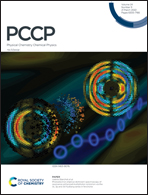Mechanism of darunavir binding to monomeric HIV-1 protease: a step forward in the rational design of dimerization inhibitors†
Abstract
HIV protease (HIVPR) is a key target in AIDS therapeutics. All ten FDA-approved drugs that compete with substrates in binding to this dimeric enzyme's active site have become ineffective due to the emergence of drug resistant mutants. Blocking the dimerization interface of HIVPR is thus being explored as an alternate strategy. The latest drug, darunavir (DRV), which exhibited a high genetic barrier to viral resistance, is said to have a dual mode of action – (i) binding to the dimeric active site, and (ii) preventing the dimerization by binding to the HIVPR monomer. Despite several reports on DRV complexation with dimeric HIVPR, the mode and mechanism of the binding of DRV to the HIVPR monomer are poorly understood. In this study, we utilized all-atomic MD simulations and umbrella sampling techniques to identify the best possible binding mode of DRV to the monomeric HIVPR and its mechanism of association. The results suggest that DRV binds between the active site and the flap of the monomer, and the flap plays a crucial role in directing the drug to bind and driving the other protein domains to undergo induced fit changes for stronger complexation. The obtained binding mode of DRV was validated by comparing with various mutational data from clinical isolates to reported in vitro mutations. The identified binding pose was also able to successfully reproduce the experimental Ki value in the picomolar range. The residue-level information extracted from this study could accelerate the structure-based drug designing approaches targeting HIVPR dimerization.



 Please wait while we load your content...
Please wait while we load your content...